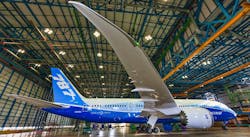Structural Issues Still Slowing 787 Production Rate
Boeing Co. has once again slowed production of the 787 Dreamliner amid efforts to resolve various structural and material defects found during the past two years in the aircraft’s wing, fuselage, and tail sections. In a statement, Boeing said "production is ongoing, and rates will continue to be dynamic," but also noted that "methodical inspection and rework efforts continue to impact 787 deliveries."
Now, some members of the U.S. House Transportation and Infrastructure Committee are seeking a new review of the Federal Aviation Administration's oversight of the 787 program. Aviation subcommittee chairman Rick Larsen and ranking member Garret Graves asked the U.S. Dept. of Transportation inspector general to determine "whether the FAA’s existing inspection program is sufficient to identify production issues, including whether FAA has enough inspectors, whether FAA performs enough inspections, and whether FAA has appropriate processes in place to identify production issues."
FAA last year initiated a historical review of the aircraft assembly operations in North Charleston, S.C. At the end of 2020, the OEM indicated it would cut the 787 production rate from 10 to five jets per month, amid slower delivery rates and falling demand for new aircraft.
The Boeing 787 Dreamliner is a twin-engine, wide-body aircraft. developed by Boeing to achieve greater fuel-efficiency for long-range service. The airframe is comprised mainly of composite materials and the design includes numerous details to improve its energy efficiency.
In September 2020, Boeing confirmed its discovery of a defect on the 787's horizontal stabilizer, as a result of some components being clamped together with excess force during assembly, which may leave the structure with wider than acceptable gaps between components.
Other defects had been found in the welded joint for two composite-material sections at the rear of the 787 fuselage; and a separate, unreliable joint on the interior surface of the fuselage. Those two flaws in combination could create out-of-tolerance gaps at that fuselage joint, according to Boeing.
Earlier this year, Boeing’s supplier Mitsubishi Heavy Industries in Japan revealed to the OEM its discovery of contamination of composite material during fabrication that could weaken the adhesive bonding between two composite parts.
In October, Boeing said some titanium components of the had been produced improperly since 2019.
A recent FAA memo summarizes the defects and offers an assessment that more than 1,000 aircraft could be affected by some or all of them. It does not characterize the issues as immediate safety concerns, but opines that they could contribute to shorter service life for an aircraft.
These are not considered an immediate safety concern but could cause premature aging of the airframe.
“We’re looking at the undelivered airplanes nose to tail, and we have found areas where the manufacturing does not conform to the engineering specifications,”.
“None of these issues is an immediate safety-of-flight issue,” a Boeing spokesperson told Reuters, noting that undelivered 787 jets are being reinspected to locate and resolve any defects.
